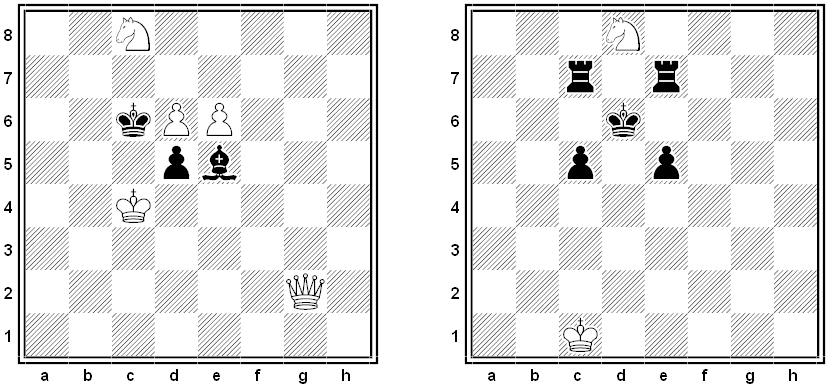A problem from the Leningrad Mathematical Olympiad: A and B take turns removing matches from a pile. The pile starts with 500 matches, A goes first, and the player who takes the last match wins. The catch is that the quantity that each player withdraws on a given turn must be a power of 2. Does either player have a winning strategy?
Puzzles
Riddles
From John Winter Jones’ Riddles, Charades, and Conundrums, 1822:
What is that which a coach always goes with, cannot go without, and yet is of no use to the coach?
Noise.
***
From Routledge’s Every Boy’s Annual, 1864:
Why is O the noisiest of the vowels?
Because all the rest are inaudible (in audible).
***
From Mark Bryant’s Riddles: Ancient & Modern, 1983:
What is big at the bottom, little at the top, and has ears?
A mountain (it has mountaineers!).
Piecework
Two ridiculous problems from Arthur Ford Mackenzie’s 1887 book Chess: Its Poetry and Its Prose:
Left: “White to mate without making a move.”
Right: “White to mate in 1/4 of a move.”
The Savage Breast
A logic problem from Lewis Carroll: What conclusion follows from these premises?
- Nobody who really appreciates Beethoven fails to keep silent while the Moonlight Sonata is being played.
- Guinea pigs are hopelessly ignorant of music.
- No one who is hopelessly ignorant of music ever keeps silent while the Moonlight Sonata is being played.
Seating Trouble
The Fall 1978 issue of Pi Mu Epsilon Journal included this problem, submitted by Pier Square. Four men are playing bridge. Their names are Banker, Waiter, Baker, and Farmer, and, as it happens, each man’s name is another man’s job. Mr. Baker’s partner is the baker, Mr. Banker’s partner is the farmer, and the waiter sits at Mr. Farmer’s right. Who is sitting at the banker’s left?
Seeing Red
University of Waterloo mathematician Ross Honsberger chose this problem for his 2004 collection Mathematical Delights; it’s a generalization of a problem that Robert Gebhardt had offered in the Fall 1999 issue of Pi Mu Epsilon Journal. Paint the outside of an n × n × n cube red, then chop it into n3 unit cubes. Put the unit cubes in a box, mix them up thoroughly, withdraw one at random, and throw it across a table. What’s the probability that it comes to rest with a red face on top?
The Bishop Problem

What is the minimum number of bishops needed to occupy or attack all squares on an 8 × 8 chessboard?
A Packing Problem
You need to pack for a midnight flight and the power is out. Your closet contains six pairs of shoes, six black socks, six gray socks, six pairs of brown gloves, and six pairs of tan gloves, but it’s too dark to distinguish colors or to match shoes. How many of each item must you take to be sure of having a matched pair of shoes, two socks of the same color, and a pair of matching gloves?
Black and White

This problem, by G. Heathcote, won second prize in the Norwich Mercury‘s “King in the Corner” problem tournament, which required that Black’s king begin each problem in one of the board’s four corners. White to mate in two moves.
Egg Hunt
A puzzle by Tim C., an applied research mathematician at the National Security Agency, from the agency’s January 2017 Puzzle Periodical:
Alice has a dozen cartons, arranged in a 3×4 grid, which for convenience we have labeled A through L:

She has randomly chosen two of the cartons and hidden an Easter egg inside each of them, leaving the remaining ten cartons empty. She gives the dozen cartons to Bob, who opens them in the order A, B, C, D, E, F, G, H, I, J, K, L until he finds one of the Easter eggs, whereupon he stops. The number of cartons that he opens is his score. Alice then reseals the cartons, keeping the eggs where they are, and presents the cartons to Chris, who opens the cartons in the order A, E, I, B, F, J, C, G, K, D, H, L, again stopping as soon as one of the Easter eggs is found, and scoring the number of opened cartons. Whoever scores lower wins the game; if they score the same then it’s a tie.
For example, suppose Alice hides the Easter eggs in cartons H and K. Then Bob will stop after reaching the egg in carton H and will score 8, while Chris will stop after reaching the egg in carton K and will score 9. So Bob wins in this case.
Who is more likely to win this game, Bob or Chris? Or are they equally likely to win?


